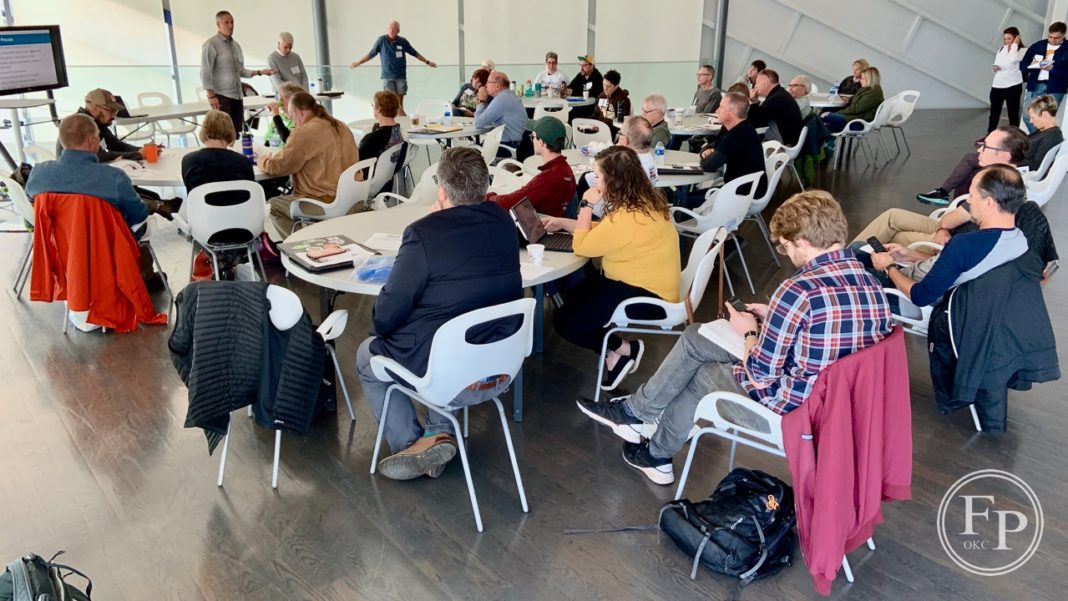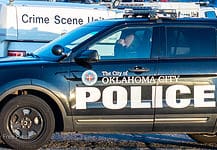Last Updated on October 27, 2019, 11:39 AM | Published: October 27, 2019
Cycling enthusiasts, advocates, and experts from across the state converged on Oklahoma City Friday and Saturday for the annual Oklahoma Bike Summit.
Organized by Bike Oklahoma, the statewide meeting of cyclists discussed new legislation, advocacy tactics, and strategies for better cycling. The first Oklahoma Bike Summit was held in 2013, and most years since bike people have gotten together each Autumn to compare notes and show solidarity.
This is only the latest in the extensive coverage Free Press has given to bike safety and infrastructure awareness in the metro.
- Death of bicyclist prompts movement demanding safe OKC streets
- Ride of Silence honors those cyclists killed by autos
- Rally calls for safer infrastructure, demonstrates protected bike lane
- Police continue search for hit and run driver in March auto-bike accident
- Bike-to-Work Day kicks off with multiple rides
See our video interviews with two of the organizers at the end of this report.
Bike Law
A highlight of Saturday’s meeting was a discussion of two changes in bicycle-related law.
Oklahoma has had a “three-foot law” for several years, requiring motorists to give three feet of space between their vehicle and a cyclist when passing. While this has been an offense for which a motorist can be cited, it has not been a “primary offense,” meaning that a motorist could be cited for the violation if they were stopped for another violation but that they could not be stopped simply for the act of passing too close.
The new law, going into effect on November 1 of this year, requires at least three feet of space at any time when passing a cyclist, making the act a primary offense.
Additionally, on any roadway with more than two lanes, a motorist is required to change lanes entirely to pass a cyclist. Furthermore, the new legislation allows drivers to cross a solid yellow lane dividing line in order to pass a cyclist.
Jason Waddell, local advocate and attorney specializing in cycling-related law, explained the changes during a Saturday morning session.
Waddell pointed out that cyclists are increasingly wearing body or helmet-mounted cameras as they ride. He said that when a motorist commits what is called a “punishment pass,” passing closer than three feet, the cyclist should now always file a police report and provide the responding officer with the video footage. If the officer refuses the footage, the cyclist should insist the officer include the footage with the report and should “explain the new law to local police,” as officers are not always up to date on changes in traffic laws.
Waddell pointed out that if a driver commits an aggressive pass, chances are it’s not the first or last time. If that driver eventually strikes a cyclist, having video evidence of past bad behavior will help in the prosecution of the crime.
Dead Red
Another change in cycling law is the addition of a “Dead Red” rule for cyclists.
Many traffic signals don’t recognize the presence of a cyclist at a stop. This can be frustrating and sometimes dangerous for cyclists. The new law allows a cyclist to run a red light after coming to a complete stop, provided there is no cross traffic and the cyclist may cross the intersection safely.
A caveat to the new rule is that if a cyclist is struck by cross traffic in this scenario, the motorist is not liable.
A fun additional thought about this: This rule has already been in effect for seven years for motorcycles. I bet you didn’t know that.
League Representation
Bill Nesper, Executive Director of the League of American Bicyclists, attended this year’s summit and spoke on several topics. Nesper lives in Washington D.C. and spoke about his experience of Oklahoma City with a perspective many of those assembled don’t have the opportunity to see.
Nesper said that he walked Saturday morning from his hotel at Main and Byers to the Devon Boathouse for the Summit. His trip included long stretches without a sidewalk, crossing the vast parking lot at Bass Pro Shop, and then the beautiful park along the canal. The dissonance of pedestrian infrastructure is profound.
This reporter rode his trusty road bike to the summit and, let me tell you, Reno is not a welcoming corridor for a solo cyclist.
“Wrong problems” for engineers
Nesper said that lacking pedestrian and cycling infrastructure isn’t the fault of city planners. “Engineers are set up to solve problems. We’re putting the wrong problems in front of them.” Most traffic engineers are given the task of moving as many cars through a space as quickly as possible. If we set up engineers to move as many pedestrians, cyclists, buses, and cars through that same space as safely as possible, the solutions become much more equitable and pleasant.
Nesper went on to share statistics gathered by the Census Bureau relating to the rise in bike commuting. He discussed the health outcomes and economic impact of bike-friendly cities and businesses. Indeed, throughout the Summit, the phrase “If you build it, they will come,” was mentioned.
Not Copenhagen
Nesper said that people in communities like Oklahoma City often say, “This is not Copenhagen.” Copenhagen and Amsterdam have some of the most bike-friendly cultures in the world.
Nesper points out that both cities were once car-centered. After World War II, residents in those places demanded that their cities protect cyclists. The culture changed by demand of the people. It is a mistake to think it was always a happy biking culture.
Roadway Deaths
Annually 40,000 people die on American Roadways. About 7,000 of those are cyclists. For some reason, we, as a culture, just accept this as the cost of having our cars.
Complete Streets
Throughout the Summit “Complete Streets” came up in discussions. Complete Streets refers to design processes determined by the U.S. Department of Transportation to be designed and operated for the safe use of all modes of transportation at once.
Many communities are approaching Complete Streets design through different methods. Striping, road “diets,” and dedicated bike lanes are all tools for designing better streets.
Some 60% of people say they would like to cycle more but are afraid. Designing more welcoming and safer streets will encourage more cycling, which will in turn spur better health outcomes for our community as well as a healthier economy.
An attendee I spoke to at the Summit was Max Harris of the Oklahoma City Planning Department. “I really enjoyed the presentations on Complete Streets. The focus on reallocation of space on streets is really encouraging.”
Us vs. Them
At the Summit I spoke to Holly Gordon of Shawnee, Oklahoma. Holly is a health advocate by nature and trade, as well as being an avid cyclist. She is also a friend of mine for over twenty years.
“Events like this encourage me. It lets me know that I’m not alone in my efforts to create access and equity to safe [cycling] routes for Oklahomans,” Gordon told me. “This event brought together advocates from across the state with a common goal. Together, we can build communities we can be proud of.”
Gordon and some fellow cyclists in Shawnee have started a group ride made up of only women. We discussed the sometimes common in-fighting of cycling communities.
For example, this writer is a commuter cyclist. I ride a single-speed road bike and stick almost exclusively to city streets as opposed to trails or gravel roads. Sometimes my advocacy goals for cycling are not the same as the fitness-oriented cycling enthusiasts. Those goals are as different as we riders. Stand us side by side and one is wearing lycra and clip-in boots and helmets, the other is me in my Vans, commuter jeans, and no helmet.
“We have to get away from the ‘Us versus Them’ mentality that we all fall into,” Holly told me, ”we all want better access and equity for all cyclists. After that we can argue about spending money on more trails versus more bike lanes.”
Columnist covering local government in Oklahoma City and Oklahoma County from May 2019 through June 2023.









